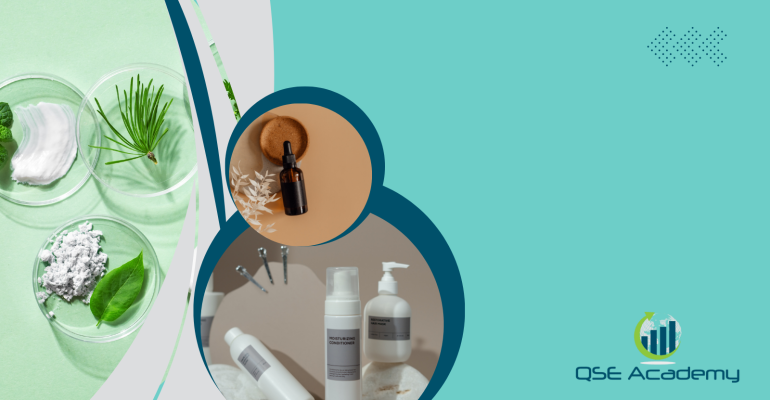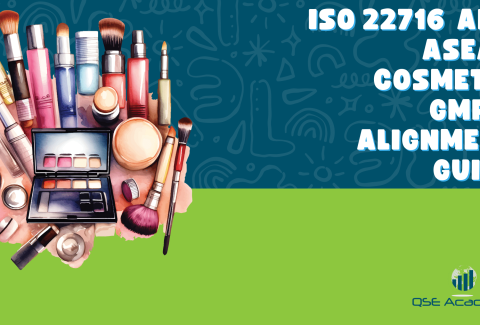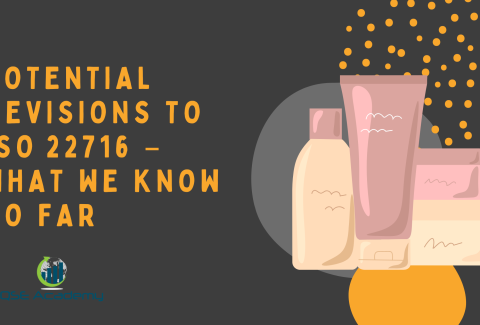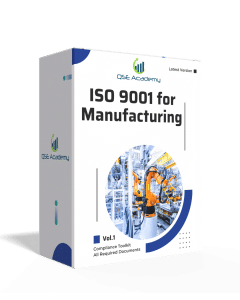Differences Between GMP and ISO 22716
Last Updated on October 24, 2025 by Hafsa J.
Differences Between GMP and ISO 22716
Let’s start by understanding the first part of the puzzle: ISO 22716. If you’re in the cosmetics industry, chances are you’ve heard this term thrown around a lot. But what exactly is it, and how does it relate to GMP (Good Manufacturing Practices)? Let’s break it down.
Defining ISO 22716
ISO 22716 is an international standard specifically designed for the cosmetics industry. It provides clear and practical guidelines for applying Good Manufacturing Practices (GMP) during the production, control, storage, and shipment of cosmetic products. Essentially, it’s a roadmap to ensure that cosmetics are consistently safe, high-quality, and meet consumer expectations.
Think of it this way: while GMP sets the general rules for safe manufacturing, ISO 22716 takes those rules and customizes them for the unique needs of the cosmetics world. It’s all about tailoring the process to ensure beauty products are safe and effective—from the moment raw materials arrive at the factory to when the finished product reaches the shelves.
Why ISO 22716 Matters
The cosmetics industry is all about trust. People are putting these products on their skin, hair, and bodies, so safety is non-negotiable. That’s where ISO 22716 comes in. By following these guidelines, manufacturers can ensure their processes minimize risks like contamination, improper labeling, or poor storage conditions.
Unlike generic GMP frameworks, ISO 22716 dives deep into cosmetic-specific concerns. For example:
- How should a moisturizer be stored to maintain its effectiveness?
- What labeling information does a lipstick need to include for consumer safety?
- How can a shampoo manufacturer ensure that each bottle meets the same high-quality standards?
ISO 22716 answers all these questions and more.
ISO 22716 vs GMP: A Cosmetics-First Approach
When comparing ISO 22716 vs GMP, one thing stands out: ISO 22716 is tailored exclusively for cosmetics. It’s designed to address the unique challenges and needs of this industry, making it a better fit for businesses that only deal with beauty products.
For example, while generic GMP might focus broadly on cleanliness and safety, ISO 22716 emphasizes specifics like:
- Protecting formulas from contamination during production.
- Detailed batch records to ensure consistency across product lines.
- Storage guidelines to keep cosmetics stable and effective.
Global Recognition
Another reason ISO 22716 is a big deal? It’s globally recognized. Many regulatory bodies around the world, including those in the EU and ASEAN regions, accept or require compliance with ISO 22716 for cosmetic manufacturers. For businesses looking to expand internationally, adopting ISO 22716 can be a major competitive advantage.
In short, ISO 22716 is like a GPS for the cosmetics industry. It guides manufacturers through the entire production process, ensuring every product is safe, consistent, and ready to meet the demands of consumers and regulators alike. And when comparing ISO 22716 vs GMP, it’s clear that this standard was made with the beauty world in mind.
What is GMP?
Now that we’ve covered ISO 22716, let’s talk about its broader counterpart: GMP, or Good Manufacturing Practices. If you’re curious about how GMP fits into the discussion of ISO 22716 vs GMP, you’re in the right place. While both focus on quality and safety, GMP casts a wider net, applying to a variety of industries, not just cosmetics.
Defining GMP
GMP is a set of general guidelines designed to ensure products are consistently manufactured and controlled according to quality standards. It’s like a universal checklist for safe and effective production, covering industries like pharmaceuticals, food, and yes, cosmetics.
The purpose of GMP is to protect consumers by preventing mistakes, contamination, and inconsistencies during manufacturing. Whether it’s a pill, a sandwich, or a face cream, GMP ensures every product is made in a clean, controlled environment with clear processes in place.
How GMP Works
GMP is all about setting and following strict rules for manufacturing. These rules cover everything from cleanliness and equipment maintenance to employee training and record-keeping. For example:
- Facilities must be clean and well-maintained to avoid contamination.
- Equipment must be regularly inspected to ensure it’s functioning properly.
- Workers must be trained to follow safety protocols and prevent errors.
This structure helps businesses create products that meet regulatory requirements and consumer expectations every time.
ISO 22716 vs GMP: A Broader Framework
Here’s where ISO 22716 vs GMP starts to become clear. While ISO 22716 is tailored specifically for cosmetics, GMP serves as a general guideline for multiple industries. For instance:
- A pharmaceutical company producing vaccines must follow GMP to ensure safety and efficacy.
- A food manufacturer making canned soup relies on GMP to prevent contamination and spoilage.
- A cosmetics company making lipsticks uses GMP to ensure consistent quality and hygiene in production.
GMP is the foundation, while ISO 22716 adapts those principles for the unique needs of the cosmetics industry.
The Regulatory Side of GMP
One key difference between ISO 22716 vs GMP is that GMP is often a mandatory requirement, enforced by regulatory bodies like the FDA in the United States or the EMA in Europe. These agencies conduct inspections to ensure compliance and impose penalties for non-compliance.
On the other hand, ISO 22716 is an international standard businesses can adopt voluntarily, often to gain credibility or meet market demands. While both aim to ensure safety and quality, GMP carries a heavier regulatory weight.
Why GMP Matters
Whether you’re manufacturing a bottle of shampoo or a batch of medicine, GMP ensures that your processes are consistent and safe. It’s about creating trust with consumers by guaranteeing that what they’re using meets high standards every single time.
When comparing ISO 22716 vs GMP, it’s clear that GMP provides a broader framework that’s essential for industries beyond cosmetics. For businesses looking to comply with regulations, avoid risks, and maintain quality, GMP is a vital part of the equation.
In summary, GMP lays the groundwork for safe manufacturing practices across industries, while ISO 22716 builds on that foundation to meet the specific needs of cosmetics. Together, they provide a comprehensive approach to quality and safety in manufacturing.
ISO 22716 vs GMP: Key Differences
Now that we’ve explored what ISO 22716 and GMP are all about, let’s dive into how they differ. If you’re trying to figure out which one is the best fit for your business—or why both might matter—it’s helpful to compare ISO 22716 vs GMP side by side. While they share some similarities, they’re not the same, and understanding the differences can make all the difference.
1. Industry-Specific Focus
One of the biggest distinctions between ISO 22716 vs GMP is the industries they target.
- ISO 22716: This is specifically designed for the cosmetics industry. It tailors Good Manufacturing Practices to address the unique challenges of producing skincare, makeup, haircare, and other beauty products.
- GMP: On the other hand, GMP is a broad framework used across various sectors, including pharmaceuticals, food, and cosmetics. It sets general guidelines for ensuring product safety and quality, no matter the industry.
For example, while GMP might focus on preventing contamination in a factory producing medicines, ISO 22716 hones in on cosmetic-specific issues like protecting the stability of a cream or ensuring proper labeling for beauty products.
2. Standard vs Regulation
Another important difference between ISO 22716 vs GMP is how they’re implemented:
- ISO 22716: This is an international standard developed by the International Organization for Standardization (ISO). It’s voluntary, meaning businesses adopt it to improve processes, build credibility, or meet market demands.
- GMP: GMP, on the other hand, is often a regulatory requirement. It’s enforced by government agencies like the FDA in the U.S. or the EMA in Europe. Non-compliance with GMP can lead to penalties, recalls, or even shutting down operations.
In short, while ISO 22716 offers flexibility, GMP is more rigid and legally binding in many industries.
3. Documentation Requirements
When comparing ISO 22716 vs GMP, documentation is another area where they differ:
- GMP: GMP places a heavy emphasis on detailed record-keeping. Every step of the manufacturing process must be documented to ensure traceability and compliance with regulatory requirements. This includes raw material records, equipment maintenance logs, and batch production details.
- ISO 22716: While documentation is also important in ISO 22716, it’s less rigid. The focus is more on maintaining records that align with the scale and nature of the business. It’s designed to be adaptable for companies of different sizes.
For example, a small cosmetics startup might find ISO 22716 easier to implement than GMP because of its more flexible approach to documentation.
4. Scope of Application
The scope of application is another key distinction in ISO 22716 vs GMP:
- ISO 22716: Exclusively applies to cosmetics, covering production, storage, and transportation of beauty products. It’s all about ensuring that your moisturizer, lipstick, or shampoo meets the highest standards.
- GMP: Has a much broader scope, covering everything from food manufacturing to medical devices. It’s designed to ensure safety and quality across multiple industries.
If you’re solely in the cosmetics business, ISO 22716 might feel more relevant to your specific needs, while GMP is essential if you work across multiple sectors.
5. Global Recognition
Both frameworks are internationally recognized, but in different ways:
- ISO 22716: Widely accepted in the cosmetics industry, particularly in regions like the European Union and ASEAN. It’s often seen as a mark of quality and professionalism.
- GMP: Mandatory in many countries, particularly for pharmaceuticals and food. Compliance with GMP is often a legal requirement for accessing certain markets.
When choosing between ISO 22716 vs GMP, consider your target market and what’s required to operate there.
Why These Differences Matter
Understanding the differences between ISO 22716 vs GMP can help you make informed decisions about compliance. Whether you need the cosmetic-specific focus of ISO 22716 or the broader framework of GMP, each has its own strengths. And for some businesses, adopting both might be the best approach to ensure safety, quality, and market success.
By knowing how these standards differ, you’re already one step closer to choosing the right path for your business!
ISO 22716 vs GMP: Which One Should You Follow?
If you’re wondering whether to choose ISO 22716 or GMP, you’re not alone. Both frameworks are incredibly valuable, but deciding which one to follow depends on your industry, your products, and your business goals. Let’s break it down so you can make an informed choice.
1. Consider Your Industry
The first thing to ask yourself is: What kind of products do you manufacture?
- If you’re exclusively in the cosmetics industry, ISO 22716 is probably the best fit. It’s designed specifically for cosmetic products like skincare, haircare, and makeup.
- If your business spans multiple industries—such as pharmaceuticals, food, or medical devices—then GMP is essential because it applies across various sectors.
For example, if you’re making a moisturizer, ISO 22716 ensures you’re meeting cosmetic-specific standards. But if you’re also producing a dietary supplement, GMP compliance becomes critical to meet food and health regulations.
2. Think About Your Market Requirements
Where do you plan to sell your products? Different regions have different expectations when it comes to compliance.
- In many countries, GMP is a regulatory requirement for pharmaceuticals and food products. If you’re exporting to regions like the U.S. or Europe, GMP compliance may be legally mandatory.
- For cosmetics, ISO 22716 is widely recognized, especially in markets like the EU and ASEAN. Adopting ISO 22716 can help you meet industry expectations and gain credibility with international buyers.
If your target market requires one or both frameworks, that’s a clear indicator of where to focus your efforts.
3. Evaluate Your Business Size and Resources
Another factor to consider is the size and resources of your business.
- ISO 22716 is often more flexible, making it easier for small and medium-sized enterprises (SMEs) to implement. Its guidelines can be tailored to your specific operations, which is great if you’re just starting out.
- GMP, on the other hand, can require more investment in documentation, audits, and staff training. While it’s essential for certain industries, it may feel overwhelming for smaller businesses with limited budgets.
For example, a small cosmetics startup might find ISO 22716 more practical, while a larger manufacturer operating in multiple sectors may need the comprehensive approach of GMP.
4. Why Not Both?
Here’s a thought: Why choose between ISO 22716 vs GMP when you can adopt both?
Many businesses find value in implementing both frameworks, especially if they want to demonstrate their commitment to quality and safety across industries. While ISO 22716 focuses on cosmetic-specific practices, GMP provides a broader foundation that can be applied to other product lines.
For instance, a company producing skincare products under ISO 22716 could also adopt GMP if they decide to expand into nutraceuticals or pharmaceuticals.
5. Long-Term Business Goals
Finally, think about where you want your business to go in the future. If you’re planning to expand into new markets or industries, adopting GMP might position you for growth. On the other hand, if your focus is solely on cosmetics, ISO 22716 can help you maintain industry-specific excellence.
Making the Right Choice
So, ISO 22716 vs GMP—which one should you follow? It really comes down to your unique needs and goals. ISO 22716 is perfect for businesses that are exclusively in the cosmetics industry, while GMP is essential for those working across multiple sectors or targeting regions with strict regulatory requirements.
The good news? Both frameworks help you achieve the same ultimate goal: producing safe, high-quality products that consumers can trust. Whether you choose one or both, you’re setting your business up for success in a competitive market.
Benefits of ISO 22716 and GMP
Now that we’ve explored the differences between ISO 22716 vs GMP, let’s talk about the benefits of these frameworks. Whether you choose one, the other, or both, implementing these standards can transform your business for the better. They’re not just about compliance—they’re about building trust, ensuring quality, and creating a competitive edge.
1. Enhancing Consumer Safety
At the heart of both ISO 22716 and GMP is the goal of keeping consumers safe.
- ISO 22716 ensures that cosmetics are manufactured, stored, and transported in ways that prevent contamination or deterioration. This means your customers can trust that your products are safe to use on their skin, hair, or body.
- GMP, with its broader application, ensures that all products—whether it’s food, medicine, or cosmetics—are safe for consumption or use.
For example, a moisturizer produced under ISO 22716 will be free from harmful contaminants, just like a medicine produced under GMP will meet strict dosage accuracy.
2. Building Consumer Trust
When customers see that a product complies with ISO 22716 or GMP, it sends a clear message: this brand cares about quality. Compliance with these standards is like a badge of trustworthiness, showing that you’re committed to delivering safe, reliable products.
Imagine standing in a store and choosing between two products. One clearly states it’s manufactured under ISO 22716 or GMP guidelines, while the other doesn’t mention anything. Which would you choose? Most people would go for the one with the visible commitment to safety and quality.
3. Improving Market Access
Both ISO 22716 and GMP can open doors to new markets.
- ISO 22716 is recognized globally as the gold standard for cosmetics manufacturing, especially in regions like the European Union and ASEAN. Many countries require or prefer ISO 22716 compliance for cosmetics entering their markets.
- GMP is often a legal requirement, particularly in industries like pharmaceuticals and food. Without GMP compliance, exporting to countries like the U.S. or Europe might not even be an option.
Whether you’re targeting international markets or expanding within your own region, these standards give your products a competitive edge.
4. Streamlining Operations
Another benefit of both frameworks is how they improve efficiency. By implementing the structured processes of ISO 22716 and GMP, businesses can:
- Reduce waste and errors.
- Improve consistency across product batches.
- Ensure that all team members follow the same high standards.
For example, GMP’s focus on documentation and audits can help you identify and fix inefficiencies, while ISO 22716’s tailored approach to cosmetics streamlines processes specific to beauty products.
5. Avoiding Legal and Financial Risks
Non-compliance can lead to product recalls, fines, or even legal action. By following ISO 22716 or GMP, you’re protecting your business from these risks.
Imagine the cost of recalling an entire batch of products due to contamination or labeling errors. Compliance minimizes the chances of such costly mistakes, saving you time, money, and reputation.
6. Strengthening Your Brand Reputation
In today’s competitive market, reputation is everything. Adopting ISO 22716 and GMP shows that your business values quality, safety, and transparency. This not only attracts consumers but also builds stronger relationships with partners, retailers, and distributors.
A brand known for following ISO 22716 or GMP is one that people can trust, which makes it easier to stand out from the competition.
Why These Benefits Matter
When you compare ISO 22716 vs GMP, it’s clear that both offer significant advantages. They’re more than just sets of guidelines—they’re tools for creating safer products, improving operations, and building a reputation for excellence.
By embracing these standards, you’re not just meeting industry expectations—you’re exceeding them. And that’s a win for your business and your customers alike!
Challenges in Implementing ISO 22716 vs GMP
While adopting ISO 22716 or GMP can bring incredible benefits, implementing these standards isn’t always smooth sailing. For many businesses, especially smaller ones, the journey to compliance can feel overwhelming. But don’t worry—with the right mindset and preparation, these challenges are manageable. Let’s break down the common hurdles and how to overcome them.
1. Understanding the Requirements
One of the first challenges businesses face when comparing ISO 22716 vs GMP is understanding what each standard requires. Both frameworks come with detailed guidelines, but they’re not identical—and that can be confusing.
- ISO 22716 focuses specifically on the cosmetics industry, which means businesses need to understand cosmetic-specific concerns like ingredient handling and product stability.
- GMP, on the other hand, applies to multiple industries, so its requirements are more general but also stricter in some cases, especially in pharmaceuticals.
Solution: Take the time to study the standards thoroughly or bring in a consultant who specializes in ISO 22716 vs GMP. Training your team to understand these requirements is also a great way to simplify the process.
2. Cost of Implementation
Let’s be real—compliance can be expensive, especially if you’re starting from scratch. Both ISO 22716 and GMP may require investments in infrastructure, training, and documentation systems.
- For example, implementing GMP might involve purchasing new equipment to meet hygiene standards or creating a more robust record-keeping system.
- ISO 22716, while more flexible, still requires changes like upgrading storage facilities to prevent contamination.
Solution: Start small. Focus on the most critical areas first, and build compliance step by step. Many businesses also find it helpful to apply for grants or funding that support quality and safety initiatives.
3. Documentation Overload
One of the cornerstones of ISO 22716 and GMP is documentation. If it’s not documented, it didn’t happen—that’s the mantra. But for many businesses, managing detailed records for every step of the process can feel like a full-time job.
- GMP places a heavier emphasis on documentation, especially for industries like pharmaceuticals, where traceability is critical.
- ISO 22716 also requires thorough records, but it’s more tailored to the needs of cosmetics manufacturers, offering a bit more flexibility.
Solution: Embrace digital tools. Software designed for compliance management can make documentation easier, more accurate, and less time-consuming.
4. Resistance to Change
Let’s face it: change can be hard. Whether it’s training staff on new procedures or overhauling old systems, implementing ISO 22716 or GMP often requires a shift in mindset—and not everyone is on board right away.
For example, employees might resist stricter hygiene protocols or feel overwhelmed by new record-keeping responsibilities.
Solution: Communicate the “why.” Help your team understand how compliance with ISO 22716 or GMP improves product quality, builds customer trust, and benefits the entire company. Offer hands-on training and create a culture that values quality and safety.
5. Keeping Up with Updates
Both ISO 22716 and GMP evolve over time. New regulations, updates, or industry trends can mean changes to the standards. Staying compliant means staying informed, which can feel like a never-ending task.
Solution: Stay proactive. Subscribe to industry newsletters, attend workshops, and join professional networks. Having a dedicated compliance officer or team can also help you stay ahead of updates.
6. Scaling Compliance for Small Businesses
For smaller businesses, implementing ISO 22716 or GMP can feel particularly daunting. Limited resources, smaller teams, and tighter budgets can make compliance seem out of reach.
Solution: Remember that compliance is scalable. ISO 22716, in particular, is designed to adapt to businesses of different sizes. Start with the basics and expand your efforts as your business grows.
Why These Challenges Are Worth Tackling
Yes, implementing iso 22716 vs gmp comes with its fair share of hurdles, but the rewards far outweigh the challenges. From building trust with customers to opening doors to new markets, these standards set your business up for long-term success.
By taking things step by step, investing in the right tools, and fostering a team that values quality, you can overcome these obstacles—and thrive in a competitive market. So, whether you’re leaning toward ISO 22716, GMP, or both, remember: every challenge is an opportunity to grow stronger and better!
Here’s a table highlighting the key differences between ISO 22716 and GMP:
| Aspect | ISO 22716 | GMP (Good Manufacturing Practices) |
|---|---|---|
| Industry Focus | Exclusively for the cosmetics industry. | Broadly applies to multiple industries, including pharmaceuticals, food, and cosmetics. |
| Type of Framework | International standard (voluntary). | Regulatory requirement (mandatory in many countries). |
| Scope | Covers production, storage, and transportation specific to cosmetics. | Covers all aspects of manufacturing across industries. |
| Documentation | Flexible documentation requirements tailored to cosmetics. | Emphasis on detailed, strict record-keeping for traceability. |
| Regulatory Enforcement | Not legally enforced; voluntary adoption for credibility. | Legally enforced by regulatory bodies (e.g., FDA, EMA). |
| Global Recognition | Recognized in the cosmetics industry worldwide, especially in EU and ASEAN. | Required for market access in industries like pharmaceuticals and food. |
| Cost of Implementation | Lower, more adaptable for small businesses. | Higher, with significant investment in infrastructure, audits, and training. |
| Customization | Tailored specifically for cosmetics manufacturers. | Generalized framework for ensuring safety and quality across various sectors. |
| Primary Goal | Ensures safety and quality for cosmetic products specifically. | Ensures safety and quality for a wide range of products. |
This table offers a quick overview of how ISO 22716 vs GMP differ in their focus, requirements, and applications, helping businesses decide which framework best suits their needs.
Conclusion: ISO 22716 vs GMP – Choosing the Right Path
When it comes to quality and safety, both ISO 22716 and GMP have a lot to offer. They share the same ultimate goal—ensuring that products are safe, consistent, and trustworthy—but they approach it in slightly different ways. Understanding their differences can help you decide which framework makes the most sense for your business.
ISO 22716: The Cosmetics Specialist
If you’re in the cosmetics industry, ISO 22716 is a no-brainer. It’s specifically designed to address the unique challenges of manufacturing beauty and skincare products. From ingredient handling to proper labeling, it tailors Good Manufacturing Practices (GMP) to the needs of cosmetics manufacturers. It’s also globally recognized, particularly in regions like the EU and ASEAN, making it an excellent choice for businesses looking to expand internationally.
GMP: The Broad-Scale Foundation
For companies that work across multiple industries, GMP provides a solid foundation for ensuring safety and quality. Whether you’re producing pharmaceuticals, food, or cosmetics, GMP’s comprehensive guidelines keep your operations consistent and compliant. It’s also a regulatory requirement in many markets, so for businesses targeting global expansion, GMP compliance is often a must.
ISO 22716 vs GMP: Why Not Both?
Here’s a thought: why limit yourself to one when you can benefit from both? Many businesses in the cosmetics industry adopt ISO 22716 for its tailored approach while also adhering to GMP for its regulatory weight and cross-industry applicability. Combining these frameworks can set your brand apart, demonstrating a strong commitment to quality and safety.
For example, a cosmetics company that also produces pharmaceutical-grade skincare might use ISO 22716 to ensure compliance with cosmetics standards while following GMP for its medical product lines.
Final Thoughts
So, how do you choose between ISO 22716 and GMP? Start by looking at your industry, product range, and market goals. Are you focused solely on cosmetics? Then ISO 22716 is your best bet. Do you operate across multiple sectors or need to meet strict regulatory requirements? Then GMP might be your priority—or you might decide to adopt both.
At the end of the day, these frameworks aren’t just about compliance. They’re about building trust, ensuring safety, and creating products that your customers can rely on. Whether you choose ISO 22716, GMP, or both, you’re taking a big step toward a stronger, more successful business.
Whether it’s ISO 9001, ISO 22000, or the cosmetics-focused ISO 22716, I’ve spent my career I’m not here to call myself an expert—I prefer “enthusiast” because I truly love what I do. When I’m not writing about standards, you’ll probably find me playing Piano 🎹, connecting with people, or diving into my next big project💫. I’m an engineer specialized in the food and agricultural industry
make ISO standards less intimidating and more approachable for everyone.
turning complex jargon into clear, actionable steps that businesses can actually use.
There’s something incredibly rewarding about helping people navigate food safety and quality management systems
in a way that feels simple, practical, and even enjoyable.
I have a Master’s in QHSE management and over 12 years of experience as a Quality Manager
I’ve helped more than 15 companies implement ISO 9001, ISO 22000, ISO 22716, GMP, and other standards
My clients include food producers, cosmetics manufacturers, laboratories, and service companies
I believe quality systems should be simple, useful, and efficient.











